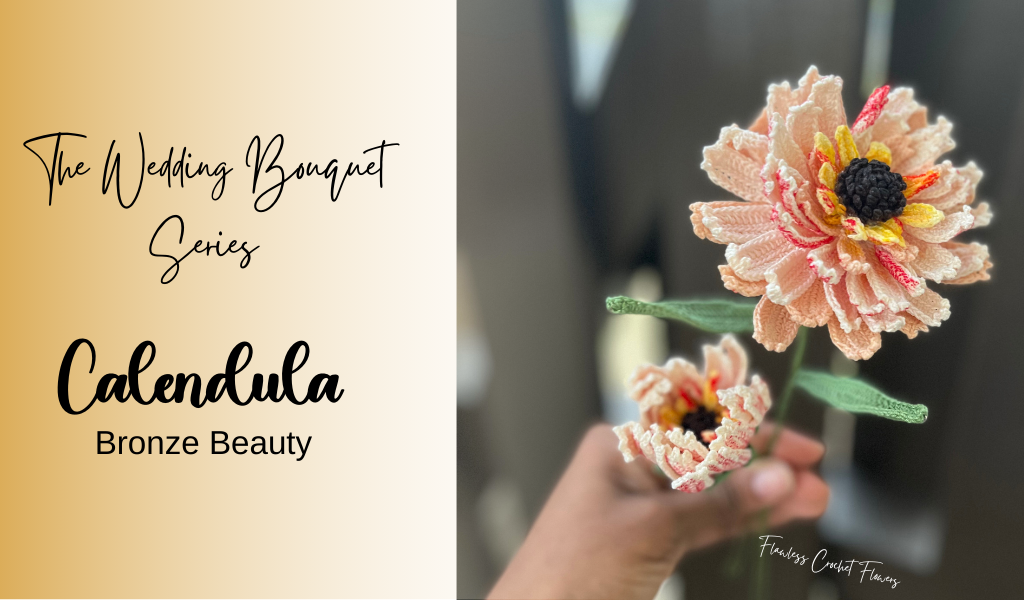Hey Gardeners!
Welcome to yet another beauty added to the crochet garden. Nestled among gardens, fields, and herbal apothecaries, there blooms a flower that has captured the hearts and imaginations of humanity for centuries: the calendula, also known as marigold. With its radiant petals and rich cultural heritage, this versatile blossom stands as a testament to the enduring relationship between humans and the natural world. And, we've turned it into a crochet masterpiece that promises to last a lifetime!
This crochet Bronze Beauty Calendula flower is the very first flower we've created for our Crochet Wedding Bouquet Series. Be sure to join us as we create the next beauty!
I'm so excited to share with you a delightful crochet flower project that will brighten up your days and infuse your creations with a touch of floral charm. Whether you've been in the crochet flower world for some time or just dipping your fingers into the crochet soil, this pattern is perfect for all skill levels.
Picture yourself strolling through a sun-kissed garden, where vibrant crochet calendula flowers move in the gentle breeze, capturing the essence of these cheerful blooms with your crochet hook and a few balls of thread. The result? A stunning masterpiece that will adorn your home decor, accessories, or your very own crochet wedding bouquet.
Here's a sneak peek!
The Full Pattern Is Available To Members Of The Garden Club. Join Here!
Besides the crochet calendula bloom, the crochet cascading wedding bouquet will also feature the following blooms that we'll be creating in this order:
- Garden Rose 'Honey Dijon'
- Rosanne Brown Lisianthus
- White Butterfly Ranunculus
- Garden Rose 'Distant Drums
- Nandina
- Button Orchids
- Jasmine Vine
- Seeded Eucalyptus
🌼🌼🌼 Fun Facts 🌼🌼🌼
- Versatility in Culinary Delights: Calendula petals add a burst of color and flavor to various culinary dishes. They are often used as a garnish in salads, soups, and rice dishes, or infused into teas and vinegars for a delicate floral taste.
- Traditional Medicinal Uses: Calendula has a long history of medicinal use, dating back to ancient civilizations such as the Greeks and Egyptians. Its petals are rich in antioxidants and have anti-inflammatory properties, making them popular ingredients in skincare products, ointments, and herbal remedies for soothing skin irritations and promoting healing.
- Symbolism and Cultural Significance: In many cultures, calendula symbolizes joy, optimism, and good luck. It is often used in religious ceremonies, weddings, and festivals to bring positivity and happiness.
- Garden Friend: Calendula is not only beautiful but also beneficial for the garden. Its bright flowers attract pollinators like bees and butterflies, promoting biodiversity and aiding in the pollination of other plants.
- Edible Flowers: Beyond their decorative use, calendula flowers are edible and offer a slightly spicy, peppery flavor reminiscent of saffron. They can be used fresh in salads or dried for later use in teas and cooking.
- Natural Dye: The vibrant orange and yellow hues of calendula petals can be extracted to create natural dyes for fabrics, yarns, and even foods, offering a sustainable alternative to synthetic dyes.
- Companion Planting: Calendula is prized by gardeners for its ability to repel pests such as aphids and nematodes, making it an excellent companion plant for vegetables like tomatoes and cucumbers.
- Historical Remedy: During World War I, calendula petals were used to dress wounds on the battlefield due to their antiseptic properties and ability to promote healing, earning them the nickname "pot marigold."
- Celebrated in Art and Literature: Calendula's vibrant colors and cheerful appearance have inspired artists and writers throughout history, appearing in paintings, poems, and folklore as a symbol of beauty, vitality, and renewal.
My favorite tools!
* Markers
🌼🌼🌼 Flower Anatomy 🌼🌼🌼
- Petals: Calendula flowers typically have bright, vibrant petals that come in shades of yellow and orange, although some varieties may have petals in other colors like apricot or cream. These petals are often arranged in multiple layers and are the most visually striking part of the flower.
- Disc Florets: In the center of the calendula flower, you'll find numerous small tubular florets tightly packed together. These disc florets are often darker in color compared to the outer petals and form a raised, domed center known as the capitulum.
- Stamen and Pistil: Within each disc floret, there are reproductive structures known as stamens and pistils. The stamens are the male reproductive organs, consisting of slender filaments topped with pollen-producing anthers. The pistil is the female reproductive organ, typically comprising a stigma, style, and ovary.
- Phyllaries: Surrounding the base of the flower, beneath the petals, are a series of green leaf-like structures known as phyllaries. Phyllaries protect the developing flower bud and are often visible even after the flower has fully opened.
- Reproductive Organs: Calendula flowers are perfect, meaning they contain both male and female reproductive organs within the same flower. This arrangement facilitates self-pollination, although the flowers are also attractive to pollinators like bees and butterflies, which aid in cross-pollination.
- Nectaries: Many species of calendula have specialized glands called nectaries, which secrete nectar, a sugary fluid that attracts pollinators. These nectaries are often located at the base of the petals or within the disc florets, providing a valuable food source for visiting insects.
- Peduncle: The peduncle is the stalk or stem that supports the flower and connects it to the main plant. In calendula, the peduncle may be relatively short, especially in smaller varieties, or longer in larger, more robust plants.
Calendula is not just a pretty flower; it's a versatile and valuable plant with a rich history and a wide range of practical uses, from culinary to medicinal to decorative. Whether in the garden, the kitchen, the medicine cabinet, and now blooming from our crochet hooks, calendula continues to captivate and inspire people around the world.
Wishing you all a blooming day ahead!
Your Garden Friend,
Leticia


